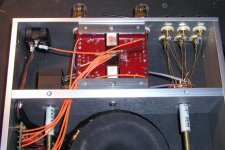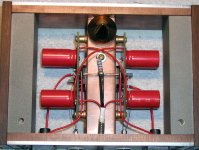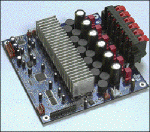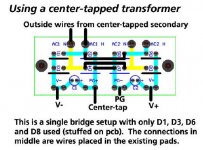Chip Amp Configurations
Peter,
Could you explain, in relatively simple terms, the difference between Parallel and Bridged configurations for amp inputs and outputs.
Also, I understand the difference between Dual Mono and Stereo as being primarily the use of independent power supplies in Dual Mono....is there any other difference?
I thought I understood all of the different concepts, but now I find myself confused regarding Bridged and Parallel. I have read the application notes for the LM3875 amps, and the posts regarding the different set-up possibilities for the LM 4780, but I think I need an overall concept of Bridged vs. Parallel to put the pieces together.
I have your kits for both the LM3875 (two) and LM4780 (three), and was planning to use the LM4780 for a 5 Ch application, but I am trying to figure out if there is a way to configure more power out of the front 2 channels without going to balanced inputs (and I don't mind adding more kits if necessary).
Sorry for the elemental questions!
Thanks,
Robert
Peter,
Could you explain, in relatively simple terms, the difference between Parallel and Bridged configurations for amp inputs and outputs.
Also, I understand the difference between Dual Mono and Stereo as being primarily the use of independent power supplies in Dual Mono....is there any other difference?
I thought I understood all of the different concepts, but now I find myself confused regarding Bridged and Parallel. I have read the application notes for the LM3875 amps, and the posts regarding the different set-up possibilities for the LM 4780, but I think I need an overall concept of Bridged vs. Parallel to put the pieces together.
I have your kits for both the LM3875 (two) and LM4780 (three), and was planning to use the LM4780 for a 5 Ch application, but I am trying to figure out if there is a way to configure more power out of the front 2 channels without going to balanced inputs (and I don't mind adding more kits if necessary).
Sorry for the elemental questions!
Thanks,
Robert
The difference between dual mono and stereo is the number of rectifier boards used in powering the amp. In stereo, both channels are powered from the same board, in dual mono each channel has its own separate board.
While in stereo setups with a single transformer you could still use two separate boards, on more than one occasion I had reports of humming supply so I always recommend using a single rectifier board.
That's also what I'm doing in all my stereo amps and in the picture below I'm showing trouble free way to connect power grounds: output grounds of both channels (OG) are connected with a piece of thick copper wire. Central point on that wire is power star ground and all 4 ground wires from rectifiers board (PG+, PG+ and PG-, PG-) are connected here. Output grounds are taken directly from the board, signal ground connects to the point on the board marked as SG.
Those boards were designed with dual mono operation in mind and as such they work well without any mods.
While in stereo setups with a single transformer you could still use two separate boards, on more than one occasion I had reports of humming supply so I always recommend using a single rectifier board.
That's also what I'm doing in all my stereo amps and in the picture below I'm showing trouble free way to connect power grounds: output grounds of both channels (OG) are connected with a piece of thick copper wire. Central point on that wire is power star ground and all 4 ground wires from rectifiers board (PG+, PG+ and PG-, PG-) are connected here. Output grounds are taken directly from the board, signal ground connects to the point on the board marked as SG.
Those boards were designed with dual mono operation in mind and as such they work well without any mods.
Attachments
Here's the same idea in a Patek amp. Boards are positioned vertically now, and I created special grooves to slide in the copper wire connecting both channel grounds. Black wires from PS ( PG+ and PG-) connect to that point and grounds to speakers are also taken from here. Amp's chassis is connected through 10R resistor.
Attachments
Parallel and bridged configurations are used to get more power from the chips. Paralleling is easier to accomplish as you simply connect inputs and outputs of both chips together, creating more current capability.. This will not really give more power into 8 ohms. Usually a single chip gives similar power into 8 ohms and into 4 ohms (at a given voltage supply) as it cannot produce more current. With paralleling, more current can be produced and the power into 4 ohms usually doubles.
A bridged configuration could be compared to using two chips in series. The balanced signal consists of two signals in opposite phases. One amp amplifies one signal, the other amp takes care of the opposite phase signal. The output is taken from between the two chips without referencing to ground. Such configuration creates higher output voltage levels, however does not have increased current capability, that's why it's not recommended to use loads below 8ohms and use moderate voltage supply levels.
The parallel configuration has no limitations with regards to source as it is still single ended. In bridged setup, a balanced signal needs to be supplied to the amp, so this requires a preamp, or source, with balanced output (those use XLR connectors, not RCAs)
You may have another look at this schematic, as it shows both ways of connecting two chips: http://www.audiosector.com/lm4780 amp.pdf
A bridged configuration could be compared to using two chips in series. The balanced signal consists of two signals in opposite phases. One amp amplifies one signal, the other amp takes care of the opposite phase signal. The output is taken from between the two chips without referencing to ground. Such configuration creates higher output voltage levels, however does not have increased current capability, that's why it's not recommended to use loads below 8ohms and use moderate voltage supply levels.
The parallel configuration has no limitations with regards to source as it is still single ended. In bridged setup, a balanced signal needs to be supplied to the amp, so this requires a preamp, or source, with balanced output (those use XLR connectors, not RCAs)
You may have another look at this schematic, as it shows both ways of connecting two chips: http://www.audiosector.com/lm4780 amp.pdf
Bridged and Parallel
Thanks Peter,
Thats exactly the kind of basic explanation I was looking for to go with the schematics.
Robert
Peter Daniel said:Usually a single chip gives similar power into 8 ohms and into 4 ohms (at a given voltage supply) as it cannot produce more current. With paralleling, more current can be produced and the power into 4 ohms usually doubles.
A bridged configuration could be compared to using two chips in series. The balanced signal consists of two signals in opposite phases. One amp amplifies one signal, the other amp takes care of the opposite phase signal. The output is taken from between the two chips without referencing to ground. Such configuration creates higher output voltage levels. The parallel configuration has no limitations with regards to source as it is still single ended. In bridged setup, a balanced signal needs to be supplied to the amp.
You may have another look at this schematic, as it shows both ways of connecting two chips: http://www.audiosector.com/lm4780 amp.pdf
Thanks Peter,
Thats exactly the kind of basic explanation I was looking for to go with the schematics.
Robert
Peter Daniel said:
That amp was actually a custom order, I'm not sure if I offer 5 channel version as a product.
You should.. I think that looks even sweeter than the usual patek. Plus, then you can reach all the hometheater people.
all digital amplifier
peter i had a chance this week to test a all digital amplifier.
and was suprized how clear it was and a very small footprint
for the watts it was pumping out.
have you had a chance to try one? what are your comments on this amplifier?
is this somthing u may build in the future?

http://sharp-world.com/products/1-bit/archives.html
http://www.electronicproducts.com/ShowPage.asp?SECTION=3700&PRIMID=&FileName=febti1.feb2003
peter i had a chance this week to test a all digital amplifier.
and was suprized how clear it was and a very small footprint
for the watts it was pumping out.
have you had a chance to try one? what are your comments on this amplifier?
is this somthing u may build in the future?
http://sharp-world.com/products/1-bit/archives.html
http://www.electronicproducts.com/ShowPage.asp?SECTION=3700&PRIMID=&FileName=febti1.feb2003
Attachments
While in stereo setups with a single transformer you could still use two separate boards, on more than one occasion I had reports of humming supply so I always recommend using a single rectifier board.
That's also what I'm doing in all my stereo amps and in the picture below I'm showing trouble free way to connect power grounds: output grounds of both channels (OG) are connected with a piece of thick copper wire. Central point on that wire is power star ground and all 4 ground wires from rectifiers board (PG+, PG+ and PG-, PG-) are connected here. Output grounds are taken directly from the board, signal ground connects to the point on the board marked as SG.
I'm a bit confused with your stereo amp setup. You say you're using a single rectifier board, but you have four ground wires from the rectifier? Shouldn't there be only two?
Also, it doesn't look like you have anything connected to PG+/PG- on the amplifier board. If grounds from the rectifier board are connected to the star ground then I assume connecting them to the grounds on the amplifier board is not necessary. Please correct me if I am wrong.
The four ground wires consist of dual PG+ and PG- connections (in parallel, to increase current capacity).
There are no wires connected to pads marked PG+ and PG- on amp board, but the copper wire (connecting both channels) connects to OG pads (which is the same ground as PG+ and PG-). The central point on that wire is a star ground, and that star ground is connected to the output ground (OG) on amp's board.
There are no wires connected to pads marked PG+ and PG- on amp board, but the copper wire (connecting both channels) connects to OG pads (which is the same ground as PG+ and PG-). The central point on that wire is a star ground, and that star ground is connected to the output ground (OG) on amp's board.
Re: all digital amplifier
I'm not familiar with this particular amplifier, but I was listening both to Hypex modules ( have actualy 3 of them ) and NuForce 9 and without mods they are not in a same league as properly implemented GC. Still, I didn't have a time to perform the mods
BTW, the Patek chassis, both stereo and 5 channels, can also acommodate Hypex modules, same for integrated amp chassis.
karma said:peter i had a chance this week to test a all digital amplifier.
and was suprized how clear it was and a very small footprint
for the watts it was pumping out.
have you had a chance to try one? what are your comments on this amplifier?
I'm not familiar with this particular amplifier, but I was listening both to Hypex modules ( have actualy 3 of them ) and NuForce 9 and without mods they are not in a same league as properly implemented GC. Still, I didn't have a time to perform the mods
BTW, the Patek chassis, both stereo and 5 channels, can also acommodate Hypex modules, same for integrated amp chassis.
The four ground wires consist of dual PG+ and PG- connections (in parallel, to increase current capacity).
Got it, thanks
Would it be a good idea to do the same (use dual PG+ and PG- connections) with the 4870 kit?
Check page 15 of this manual: http://www.audiosector.com/nigc_kit-users_guide.pdf
All-In-One Premium DAC
Peter,
I finally got my AllInOne powered up and it is very nice indeed. I set up an A-B listening test between it and the on-board DAC in my Denon DVM-2815 using an A-B switch and then powering the signals through an M3 headamp to my Senn HD600s. Using Vangelis as my program, I've listened to about an hours worth of music so far.
When first powerd on, the ALLInOne was a little narrow and tight, but within about 15 minutes, it opened up nicely to a full rich sound. I also had to reverse the CD analog inputs to my A-B switch so the switching between inverted and non-inverted wouldn't throw off my comparisons from ear to ear.
The AllInOne seems a little fuller in the bass end to me, but I don't hear much difference in the highs (could be my 60 yr old ears though). Soundstage with this source was about the same between the Denon and the ALLInOne, but there were differences in the emphasis on different instruments. It might be more dramatic with a less digitally orchestrated program.
Overall, a very full rich sound, with nothing missing! I really like it. Now a case for it! And time to begin the second one.
Robert
A few pics of the setup:
Peter,
I finally got my AllInOne powered up and it is very nice indeed. I set up an A-B listening test between it and the on-board DAC in my Denon DVM-2815 using an A-B switch and then powering the signals through an M3 headamp to my Senn HD600s. Using Vangelis as my program, I've listened to about an hours worth of music so far.
When first powerd on, the ALLInOne was a little narrow and tight, but within about 15 minutes, it opened up nicely to a full rich sound. I also had to reverse the CD analog inputs to my A-B switch so the switching between inverted and non-inverted wouldn't throw off my comparisons from ear to ear.
The AllInOne seems a little fuller in the bass end to me, but I don't hear much difference in the highs (could be my 60 yr old ears though). Soundstage with this source was about the same between the Denon and the ALLInOne, but there were differences in the emphasis on different instruments. It might be more dramatic with a less digitally orchestrated program.
Overall, a very full rich sound, with nothing missing! I really like it. Now a case for it! And time to begin the second one.
Robert
A few pics of the setup:
An externally hosted image should be here but it was not working when we last tested it.
An externally hosted image should be here but it was not working when we last tested it.
An externally hosted image should be here but it was not working when we last tested it.
- Status
- This old topic is closed. If you want to reopen this topic, contact a moderator using the "Report Post" button.
- Home
- More Vendors...
- Audio Sector
- AudioSector-chip amp kits, dacs, chassis



